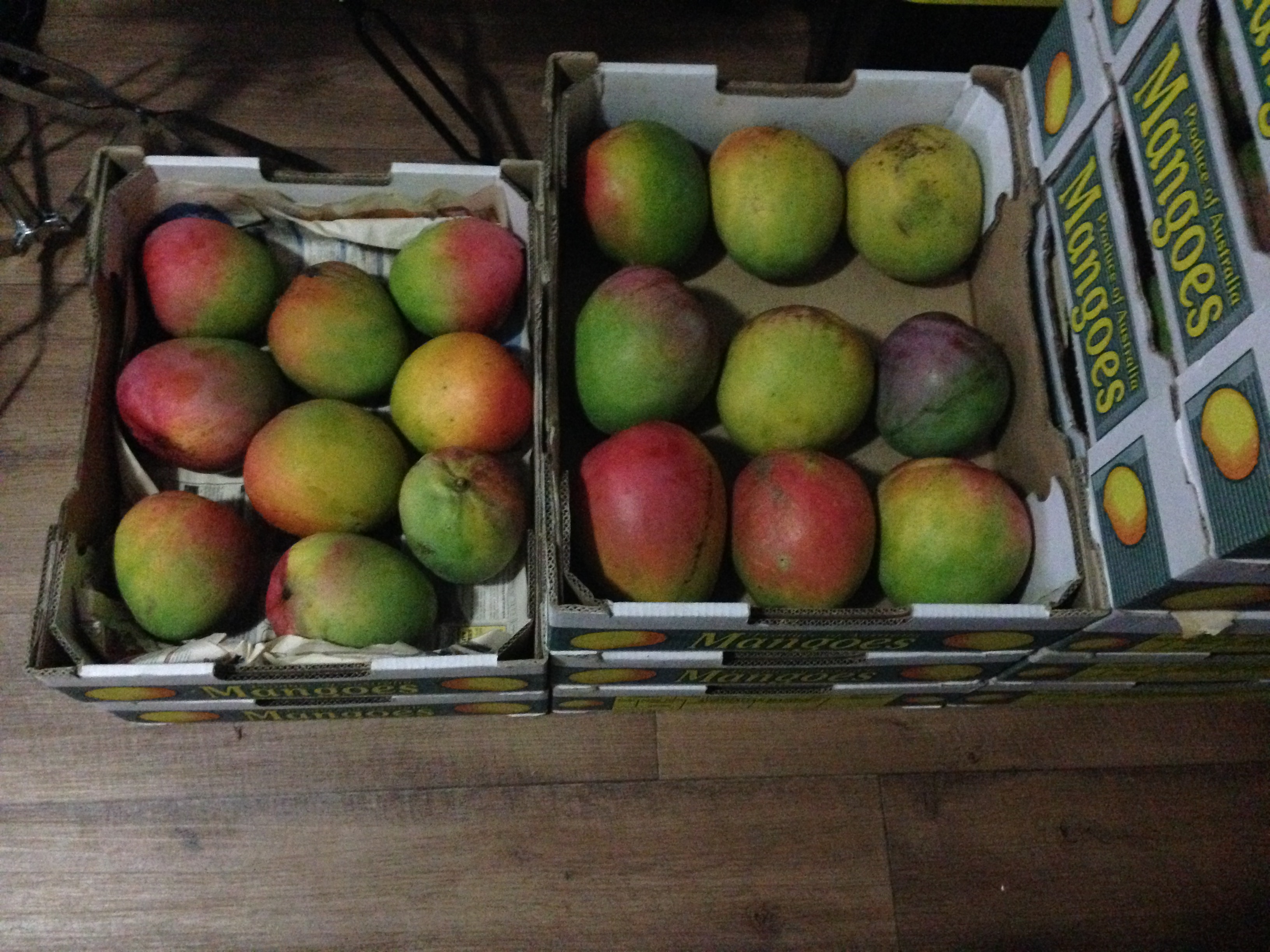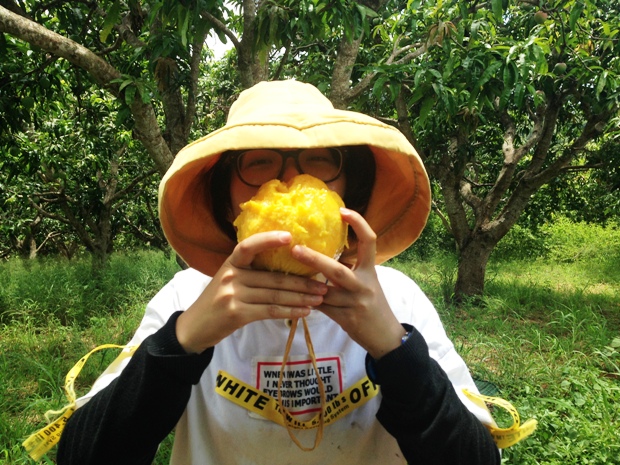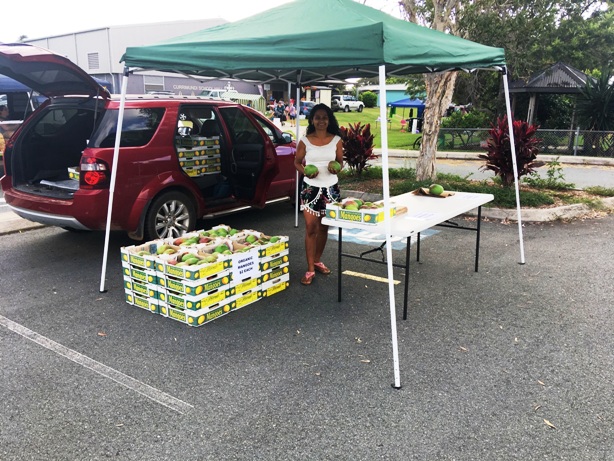Have We Forgotten The Taste Of Real Mangoes?
Ever wondered why the “yellow” mangoes on display at the supermarket have no aroma?Supermarket mangoes have been so processed that they have lost their true identity. Buy them long enough and it is easy to forget what real mangoes taste like. I did. I used to pick mangoes from the tree as a child and when I grew up, I bought mangoes from supermarkets and forgot what it was like to hold and smell a mango, freshly picked from the tree…that is until I acquired my own Bundy Special mangoes best tasting orchard.

Our Bundy Special mangoes
Standing in the midst of a few hundred trees, their branches laden with Bundy Special mangoes best tasting, I basked in the aroma of the ripe, freshly picked mangoes in my basket.

Real mangoes have blemishes. When a mango is too perfect that is when you start worrying
Jade, a young lady from China who lived with us during harvest season, helped me pick mangoes off our tree and one day while picking together, she said to me, “Your mangoes are bad for me.”
Startled, I responded, “Why do you say that, Jade?”

Jade likes to bury her face in the mango while eating
“Once I go back I will never be able to eat mangoes again because I have tasted the best and everything else will not match up,” she continued.
I laughed. Our mango picking routine involved taking breaks by eating plump, fleshy mangoes. These sort of breaks are unheard of at a typical commercial farm.
Fortunately for us, we can appreciate the precious gift that each and every mango is to us and while we do sell them, they are not treated as commodities but an important source of sustenance and a privilege to eat, when it is chemical-free and fresh.

Bundy Special Mangoes Best Tasting
I still recall juice pouring down our wrists and arms as Jade and I devoured our mangoes. Then we looked at each other and laughed because we had yellow pulp all over our cheeks and nose. Jade had this habit of burying her face in a ripe mango and slurping.
It is a feat to get to the mangoes because they are on top of the mountain. However, the breath-taking sight at the top makes it well worth the steep climb.
Once you’ve drunk in the view, turn around and you will see majestic mango trees amongst the forest backdrop.
It’s quite a sight to behold. Why? Because you won’t be looking at a monoculture crop [rows and rows of the same cultivar in one spot] but a crop that is grown amongst the natural forest. To the untrained eye, our farm might look wild and unkempt but therein lies its rich biomass which contributes towards a rich soil, leading to the most nutritious and delicious mangoes you will ever taste.
The Bundy Special mangoes best tasting, form a purple tinge as it ripens, and when the sun hits, they get a pink blush, which is so attractive.

At the market
While selling mangoes at the market, a lady visited our mango stall and asked for a taste. We had slices laid out on a plate to sample.
“I am a mango farmer and I have ten thousand trees,” she told us. “We export our mangoes and the Japanese always pay top dollar for the mangoes with the pink blush.”
I asked if she sprays her mangoes and she said, “Of course. You have to spray if you want them to be commercially viable.”
Commercially viable! We’ve heard so much advice on how to make our mangoes commercially viable and we’re glad we rejected all of them, especially the need to spray chemicals. Now that we’ve had experience with our own mangoes, let me bust a few myths:
Myth 1 – It’s impossible to get a good harvest of mangoes if you don’t spray your trees.
There are chemicals to induce flower production, chemicals to deter pests and the chemical applications don’t end when the mangoes are picked. After picking they are subjected to a chemical wash to prevent sap burn and even submerged in hot water to kill fruit fly larvae and prevent anthracnose disease [blackening of the skin of the mango]. All these destroy the quality of the mango, not to mention dangerous to eat because it has been exposed to chemicals.
While our mangoes were still green on the tree we did our housekeeping such as picking up all the mangoes that had fallen pre-maturely and protecting trees with fruit fly baits instead of spraying with chemicals. If the trees are healthy they are less susceptible to disease.
They stay healthy the same way we humans stay healthy – by eating right. Their nutrition comes from the rich, red soil on our property and what we feed the soil.
At harvest time, we had thousands of great mangoes – so good that retail shops were ordering from us. So this myth that you have to spray is just a short-cut to circumvent hard work.
“Be prepared to lose 60% of your crop,” a manager of a farm that sprays chemicals warned me. “This is why organic produce costs more – more work involved and they need to recover their losses.”
Isn’t that part of nature, though? To share with the wildlife and they, in turn, propagate, pollinate, distribute and enrich the soil with their waste and distribute good bacteria with their saliva. When did we lose our sense of living in harmony with nature? I believe it’s when we made “profit” our number one goal and forgot our responsibility of being good stewards of the environment.
Genuine farmers care for their livestock, the land and care about the health of people consuming their produce. But most of the people who grow the food you eat are not farmers. They are large corporations that do not have an intimate connection with the land and the fruit it produces
Myth 2 – Organic produce enrich organic farmers
Retail shops want our mangoes at dirt cheap prices and at one time it looked like it simply was not worth the effort picking the mangoes to sell. However, if we sold them at the market ourselves, then it was worth it.
However, even at the market, the genuine farmers get a raw deal. Our spot was right at the back and the busy/popular section of the market was filled with distributors instead of farmers. These distributors simply buy the produce/fruit from Brisbane and bring them over to the markets to sell. These fruits and vegetables are not fresh. And they have been treated with all sorts of chemicals to keep them artificially fresh.
It is sad that consumers don’t know how to tell the difference or don’t care to know. Just because they buy from the market does not mean every stallholder is the farmer who grew that produce.
I would advise consumers to buy directly from organic farmers to ensure their bodies are receiving the highest quality food and farmers can concentrate on looking after their crops instead of competing with distributors at market stalls or forced to sell to retail shops at dirt cheap prices.
Myth 3 – Fruit and vegetables at every farmer’s market is fresh
It is fresh only if you buy the fruits and vegetables from the farmer who grew them. We picked our mangoes every few days which meant when we showed up at the markets they were as fresh as can be. We did the same for the shops. This also means that we allow the fruits to ripen on the tree. This results in much tastier fruits with a sweet aroma.
No crop matures at the same time, but commercial farms do not appreciate or take pride in growing/farming and do not care about the health of the consumers. They will harvest within a short period and gas their fruits
“All our mangoes have to be off the trees by harvest time. It simply isn’t cost effective for us to keep bringing workers back to the farm for harvest,” said a chemical-spraying farmer.
Myth 4 – You need to wash your mangoes in a chemical wash after picking to prevent sap burn.
A white sap gushes out when you break the stem of the mango. This sap can burn the skin of the mango and leave an ugly mark. So commercial farmers pick the mangoes with the stem attached and then wash them with chemicals before breaking the stem. This chemical leaves a wax on the mangoes and prevents the sap from sticking onto the skin of the mango and burning it.
We got around this by simply washing the mangoes in water mixed with organic detergent. Then we broke the stems and propped them up in an egg-shell like container, bottom down – only this container has the bottom cut out so that the mango can “bleed” it’s sap out. In this way we didn’t have to use chemical wash.
Personally, I prefer to skip even this procedure as the sap doesn’t bother me. Neither does the discolouration. Sap burn is not the only reason the mango gets discoloured. When a mango ripens at room temperature, it is normal for black spots to appear. It is just the normal process of ripening. Often these blemished fruits are the sweetest and tastiest.
Too much emphasis is placed on the appearance of fruits and not on the quality. Fortunately, those who bought from us understand that “real” fruits come in different sizes and do not have this uniform look. Neither do they look perfect but they taste perfect with their wholesome goodness intact and not destroyed by unnecessary processing.
In the name of uniformity of appearance hundreds of thousands of perfectly good fruit are discarded and not allowed to reach the supermarket aisles simply because they are smaller or larger or have some blemishes. So much wastage!
Myth 5 – Commercial mangoes have to be submerged in hot water to kill fruit fly larvae and prevent anthracnose disease [blackening of the skin]

Make your own mango chilli sauce
All these destroy the quality of the mango and when mangoes are treated to a hot water bath, to me, they are no longer raw but cooked mangoes. In the last decade, irradiation has replaced the hot water bath. Irradiation is subjecting the fruit to radiation. Not only is it dangerous to eat, but it changes the DNA of the fruit and kills the nutrition. This is also done to increase the shelf life of the fruit as it kills all pathogen, but it also kills the good bacteria and we’re basically eating “dead” food when we consume it.
I turned some of these mangoes into condiments like mango chilli sauce, mango ice cream and mango smoothies topped with home-made granola. It is so much more rewarding and healthy to make your own sauces. Join our upcoming “Condiments” workshop to learn more about making essential sauces that will go complement many different meals.
Subscribe now to stay informed on workshops!



0 Comments